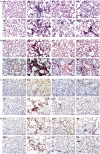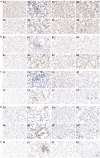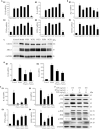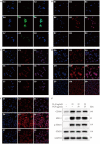Yangqing Chenfei formula alleviates crystalline silica induced pulmonary inflammation and fibrosis by suppressing macrophage polarization
- PMID: 37946475
- PMCID: PMC10623247
- DOI: 10.19852/j.cnki.jtcm.20230517.003
Yangqing Chenfei formula alleviates crystalline silica induced pulmonary inflammation and fibrosis by suppressing macrophage polarization
Abstract
Objective: To explore the underlying mechanisms of the effects of Yangqing Chenfei formula (, YCF) on inflammation and fibrosis in silicosis via inhibition of macrophage polarization.
Methods: A silicotic rat model was established via a single intratracheal instillation of silica particles on the first day of week 0. Subsequently, YCF was administered intragastrically to silicotic rats during weeks 0-2 and 5-8 twice daily. The mouse-derived alveolar macrophage cell line was used to investigate the mechanisms of YCF in M1/M2 polarization.
Results: YCF treatment effectively inhibited lung pathological changes, including inflammatory cell infiltration and tissue damage, and increased the forced expiratory volume in the first 0.3 s, functional residual capacity, and maximal mid-expiratory flow in weeks 2 and 8. Furthermore, the treatment improved lung functions by upregulating tidal volume, pause increase, and expiratory flow at 50% tidal volume from weeks 5 to 8. Moreover, YCF could significantly suppressed the progression of inflammation and fibrosis, by reducing the levels of inflammatory cytokines, as well as collagen- I and III. YCF treatment also decreased the numbers of macrophages and M1/M2 macrophages and the level of transforming growth factor-β (TGF-β). Additionally, YCF5, the effective substance in YCF, decreased lipopolysaccharide and interferon-γ-induced M1 macrophage polarization in a concentration-dependent manner. The mechanism of anti-M1 polarization might be related to a decrease in extracellular signal-regulated kinase, c-JUN N-terminal kinase, P38, and P65 phosphorylation. Furthermore, YCF5 inhibited interleukin-4-induced M2 macrophages by decreasing the protein and mRNA expressions of arginase-1 and CD206 as well as the levels of profibrotic factors, such as TGF-β and connective tissue growth factor. The mechanisms underlying the anti-M2 polarization of YCF5 were primarily associated with the inhibition of the nuclear translocation of phosphorylated signal transducer and activator of transcription 6 (p-STAT6).
Conclusion: YCF significantly inhibits inflammation and fibrosis in silicotic rats probably via the suppression of M1/M2 macrophage polarization mediated by the inhibition of mitogen-activated protein kinase and nuclear factor kappa B signaling pathways and Janus kinase/STAT6 pathways.
Keywords: Yin deficiency; cohort studies; fur; heart failure; risk factors.
Figures




Similar articles
-
Yangqing Chenfei formula alleviates silica-induced pulmonary inflammation in rats by inhibiting macrophage M1 polarization.Chin Med. 2023 Jun 28;18(1):79. doi: 10.1186/s13020-023-00787-9. Chin Med. 2023. PMID: 37381044 Free PMC article.
-
Yangqing Chenfei formula attenuates silica-induced pulmonary fibrosis by suppressing activation of fibroblast via regulating PI3K/AKT, JAK/STAT, and Wnt signaling pathway.Phytomedicine. 2023 Feb;110:154622. doi: 10.1016/j.phymed.2022.154622. Epub 2022 Dec 22. Phytomedicine. 2023. PMID: 36577208
-
Integration of serum pharmacochemistry with network pharmacology to reveal the potential mechanism of Yangqing Chenfei formula for the treatment of silicosis.J Tradit Chin Med. 2024 Aug;44(4):784-793. doi: 10.19852/j.cnki.jtcm.20240610.005. J Tradit Chin Med. 2024. PMID: 39066539 Free PMC article.
-
[Research progress of macrophage polarization in silicosis fibrosis].Zhonghua Lao Dong Wei Sheng Zhi Ye Bing Za Zhi. 2024 Apr 20;42(4):315-320. doi: 10.3760/cma.j.cn121094-20230306-00067. Zhonghua Lao Dong Wei Sheng Zhi Ye Bing Za Zhi. 2024. PMID: 38678001 Review. Chinese.
-
Macrophage polarization and its impact on idiopathic pulmonary fibrosis.Front Immunol. 2024 Jul 26;15:1444964. doi: 10.3389/fimmu.2024.1444964. eCollection 2024. Front Immunol. 2024. PMID: 39131154 Free PMC article. Review.
References
-
- Fernández Álvarez R, Martínez González C, Quero Martínez A, Blanco Pérez JJ, Carazo Fernández L, Prieto Fernández A. . Guidelines for the diagnosis and monitoring of silicosis. Arch Bronconeumol 2015; 51: 86-93. - PubMed
-
- Rimal B, Greenberg AK, Rom WN. . Basic pathogenetic mechanisms in silicosis: current understanding. Curr Opin Pulm Med 2005; 11: 169-73. - PubMed
-
- Leung CC, Yu ITS, Chen W. . Silicosis. Lancet Lond Engl 2012; 379: 2008-18. - PubMed
-
- Reynolds K, Jerome J. . Silicosis. Workplace Health Saf 2021; 69: 51. - PubMed
Publication types
MeSH terms
Substances
Grants and funding
LinkOut - more resources
Full Text Sources
Medical
Research Materials
Miscellaneous
